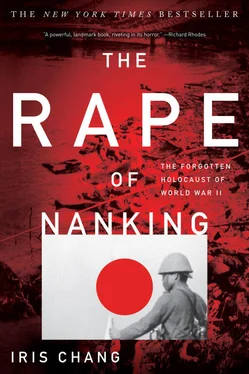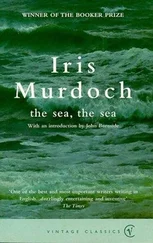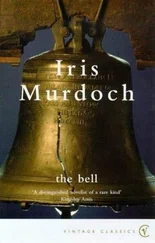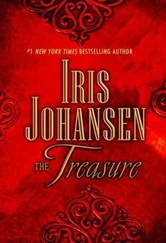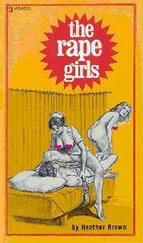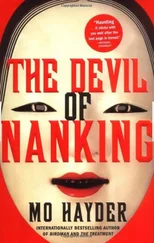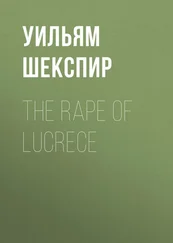Slowly the city came back to life. People could be seen ransacking houses throughout Nanking—ripping out floorboards and wood paneling for firewood and carting away metal and brick to repair their own homes or to sell on the streets to others. On Shanghai Road in the Safety Zone, dense crowds of people clustered before hundreds of vendors who sold every kind of loot imaginable, including doors and windows. This activity jump-started the local economy, for next to the roadside merchants of booty mushroomed new teahouses and restaurants.
On January 1, 1938, the Japanese inaugurated a new city government: the Nanking Self-Government Committee (the Nanjing zizhi weiyuanhui )—or “Autonomous Government,” as some of the Westerners in the city called it. The Self-Government Committee was staffed with Chinese puppet officials who controlled the city’s administration, welfare, finance, police, commerce, and traffic. By spring Nanking was outwardly starting to function like a normal city again. Running water, electric lighting, and daily mail service resumed. A Japanese city bus service started, rickshas appeared in the streets, and people could take the train from Nanking to Shanghai. Nanking quickly became a busy shipping center for the Japanese as small locomotives, horses, field pieces, trucks, and other supplies were ferried daily from the city to nearby Pukow.
But signs of a brutal occupation were everywhere. Chinese merchants endured heavy taxes and rent extortion to finance the salaries of the new officials in power. The Japanese also opened up military shops for the Chinese populace that drained the city of Chinese gold and money and replaced it with worthless military currency. The Chinese puppet government compounded the poverty by confiscating valuables and stocks of inventory that remained in the city, even if the owner was still in town, leading some of the lower Chinese officials to joke cynically among themselves: “We are now doing an authorized plundering.”
Far more alarming than the exploitation of the populace by taxes and confiscation was the reappearance of opium in the city. Before the Japanese occupation, opium was an underground narcotic, secretly smoked in the back rooms of Nanking by aristocrats and merchants. But it was not sold openly and brazenly in the streets, nor was it conspicuously paraded before young people. After the fall of the city, people could freely stroll into opium dens without interference from the police. These dens boldly advertised the drug with Chinese character shingles marked Kuang To, or “Official Earth”—a term used for opium.
To encourage addiction and further enslave the people, the Japanese routinely used narcotics as payment for labor and prostitution in Nanking. Heroin cigarettes were offered to children as young as ten. Based on his research, the University of Nanking history professor Miner Searle Bates concluded that some fifty thousand people in the Nanking area were using heroin—one-eighth of the population at the time.
Many of the downtrodden citizens of Nanking fell prey to drugs because it gave them the means to escape, if only temporarily, from the misery of their lives. Some even tried to use opium to commit suicide, swallowing large doses as poison. Others turned to crime to support their addiction, causing a wave of banditry to sweep through Nanking. After making conditions ripe for banditry in Nanking, the Japanese used the epidemic of crimes to justify their occupation, preaching the need for imperial law and order.
Japanese employers treated many of the local Chinese laborers worse than slaves, often killing them for the slightest infractions. Survivors later claimed that a harsh environment and capricious punishment were deliberately imposed upon the workplace to keep Chinese employees in a constant state of fear. One Chinese man who worked in a factory seized by the Japanese described the horrors that he witnessed there over the period of a few months. When a fellow employee was falsely accused by a Japanese overseer of stealing his sweater, he ended up being wrapped with rope, almost mummylike, from feet to throat and then stoned to death with a heap of bricks. By the end of the stoning, the body had lost all shape, and the flesh and bones, entwined with the rope, was thrown to the dogs as food. Another time, the Japanese found four small shoulder pads missing from the factory and discovered they had been used as toilet paper. A twenty-two-year-old woman who admitted that she had used the toilet that day was dragged behind the factory and beheaded with a knife. That very afternoon the same Japanese murderer also killed a teenage boy whom he accused of stealing a pair of slippers.
The Japanese even inflicted medical experiments on the Nanking people. In April 1939, they opened up a facility in the city to conduct research on human guinea pigs whom they called zaimoku, or “lumber.” On East Chungshan (or Zhongsan) Street, only a short walk from the Yangtze River, the Japanese converted a six-story Chinese hospital into a laboratory for research in epidemics, which they named Unit Ei 1644. Though the laboratory was situated near a military airport, a geisha district, movie theaters, and conspicuous Japanese centers such as the Japanese consulate, the military police office, and the headquarters for the Chinese Expeditionary Force High Command, it remained a closely guarded secret. A high brick wall surrounded the compound, topped with barbed wire; the facility was patrolled by guards; the staff was ordered never to mention Ei 1644 in their letters back to Japan. Inside scientists injected or fed Chinese prisoners with a variety of poisons, germs, and lethal gases; the substances included doses of acetone, arsenate, cyanide, nitrite prussiate, and snake poisons such as cobra, habu, and amagasa venom. The Japanese scientists killed about ten or more people weekly in this manner and disposed of them in the Ei 1644 incinerator.
When the Japanese surrendered in August 1945, the staff of Ei 1644 destroyed their equipment and data, blew up the laboratory, and fled before Chinese troops could reach Nanking. We know about this secret laboratory only because some scientists of the unit confessed their activities to American interrogators after the war.
Those Chinese in the city fortunate enough to escape the physical brutality, the Japanese medical experiments, and the lure of drugs lived under a suffocating atmosphere of military intimidation. The Japanese authorities devised a method of mass control by organizing the population into a pyramidal hierarchy. Every ten households were ordered to appoint a head man, and every ten of those heads were ordered to appoint another head, and so on. Under this system, every man in Nanking was required to carry a registration card signed by his heads of ten, one hundred, and one thousand men attesting to his loyalty to the new government. Every person was also required to report the presence in his household of any unknown or unregistered person to the immediate head of ten, who reported it to his direct head, and on up until the news reached the district officer of the city government. This was not a Japanese invention, but a traditional Chinese system called baojia , revived, no doubt, by the Japanese to legitimize their rule among the natives in Nanking.
The Japanese subjected this baojia system to frequent tests, sometimes releasing men without passes in the city to see if they could find a place to stay. If the men were not caught and reported within two hours, the heads of the groups in the neighborhoods where they stayed would be severely punished. “This,” the committee member Albert Steward wrote in his diary in 1939, “is supposed to be the Japanese way of preserving loyalty to the new regime.”
In spite of war, fire, and massacre, Nanking recovered. The dreaded famine never struck, not only because the Japanese eventually permitted shipments of food to enter the city, but because local farmers were able to harvest winter wheat crops after most of the Japanese troops left Nanking to pursue Chinese forces inland. Within the space of a year, much of the agriculture in the fertile Yangtze delta area produced yields close to prewar levels. This is not to say that Nanking did not suffer food shortages under Japanese occupation. The gardens and farms inside the city walls failed to thrive because soldiers not only confiscated vegetables from them but forced the farmers to dig up and transport the produce for Japanese use. Also, as the war dragged on, Japanese authorities in Nanking tightened their hold on supplies and heavily rationed necessities such as coal and rice. But there is no evidence to suggest that Nanking endured worse hunger or malnutrition than other areas in China. Other cities, such as the new Nationalist capital of Chungking, had suffered far worse food shortages during the war.
Читать дальше
